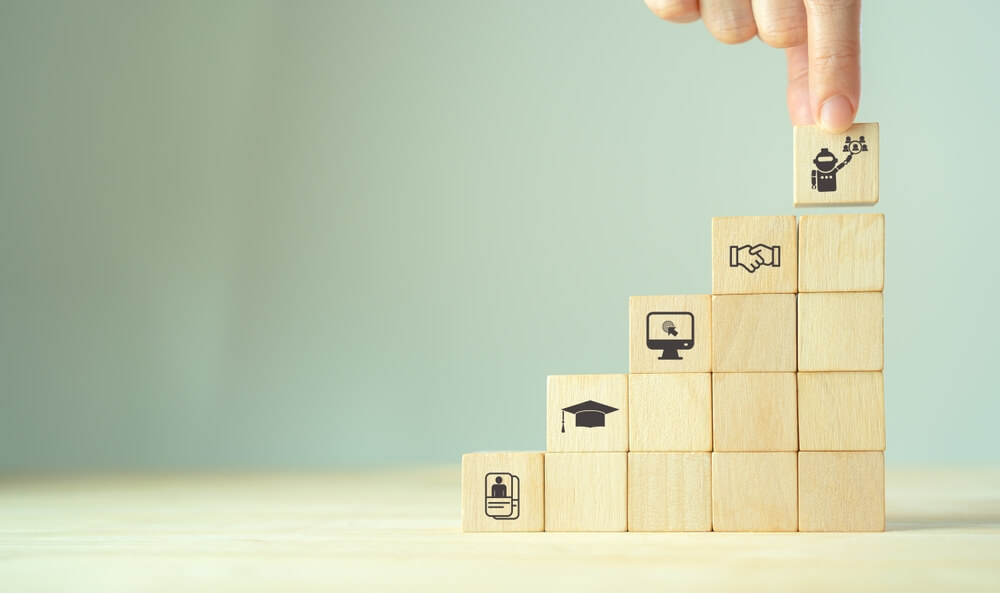How to Build Customer Success & Account Management Capability in Your Organisation
Customer success and account management teams are crucial in supporting and making customers happy. They’re essential throughout every step of the customer lifecycle to ensure the best customer experience for both new and existing customers.
We understand there’s a lot of pressure to get customer success and account management right, which is why we created this guide covering how to define, create and build them in a step-by-step process.
What is customer success & account management capability?
Customer success and account management capabilities are a mix of the knowledge, skills, tools, processes and behaviours that combine to deliver on organisational objectives. Strong customer success and account management capability helps organisations manage customer relationships, ensure customer satisfaction and drive revenue growth with repeat business.
3 steps to define customer success & account management capabilities
Before you can begin defining and creating capabilities, you need to understand what customer success and account management does for your business.
Step 1: Define the landscape
Start with evaluating the business environment that customer success and account management functions within. Understanding this is a three-step process:
- What is the organisation’s greater mission, purpose and values?
- What role does customer success and account management play in that mission?
- What value does customer success and account management generate for the business, now and into the future?
You need to understand your business strategy in order to understand how customer success capabilities interact with it. Think of your strategy and goals as the guiding star for capability building, allowing you to align L&D with your desired outcomes.
Step 2: Define the purpose
Then you need to consider the purpose of the capability in the organisation. Every capability needs to play a unique role in the grand scheme of customer success. To ensure you achieve this, there are five factors to think about when evaluating a capability’s purpose.
- How does the capability help a company achieve its strategic goals?
- Is there market demand for the capability?
- Does the organisation have the resources to sustain the capability?
- Does the capability complement or cannibalise existing capabilities?
- What risks are associated with building and sustaining the capability?
Step 3: Define the outcome
When it comes to naming the capabilities, they should be descriptive of a specific desired outcome. This shouldn’t be surprising—after all, capabilities are used to inform job descriptions, performance management, and career planning.
So, for example:
- Increased customer satisfaction
- Building and maintaining relationships with key customers
- Identifying and addressing customer needs and concerns.
If you’re still having trouble coming up with capabilities, you can always find third-party capability frameworks or pre-built examples to help you get started. We’ve curated a list of customer success and account management capabilities available for free for you to use, complete with descriptions and competency levels. And, if you’re looking for adjacent capabilities, we also have lists of customer support and quality management capabilities.
Just remember to change up the wording of any capabilities you source from third parties. This way, you can be sure the capabilities fit within the context of your organisation’s brand and voice.
Strategies for building customer success & account management capability
Now we come to actually developing customer success and account management capability in your organisation. The process of developing and building capability is generally a structured 6-step process.
- Get the buy-in of leadership
- Create co-ownership between HR and the customer success function
- Evaluate capability gaps
- Measure capability maturity
- Implement L&D methods to build customer success and account management capability
- Track and monitor progress.
Engaging leadership
Getting leadership to champion learning is the key to moving forward with long-term organisational change. In fact, 70% of change programs fail to achieve their goals, mostly because of a lack of support from leaders.
So, the key to getting the most value out of L&D is to secure the buy-in of your customer success leaders, by framing the importance of it in terms of the KPIs they actually care about. Maybe it’s increased customer loyalty and retention, improved cross sales, or better customer outcomes. Whatever the exact metric is, it’ll likely show the pain points and goals that leadership measure success by.
Co-ownership between HR and customer success & account management
Support for capability-building programs doesn’t begin and end with leaders. It’s also important to create shared accountability between HR and customer success and account management, so that both sides can champion learning together.
When we talk about shared accountability, we mean that neither customer success nor HR should be solely responsible for L&D. When control of the design and implementation of L&D is siloed, training becomes skewed too far in line with HR or customer success teams’ priorities. For example:
- When HR is in charge, training is aligned with business goals (good, obviously), but disconnected from the needs of specific business units (not so good, because it’s disconnected from customer success and account management departments).
- When customer success managers are in charge, training is aligned with their specific needs and goals, but may not address business strategy and the direction it can provide.
In short: When HR works with your customer success team, you’ll have a well-rounded and relevant training program to build account management and customer success capability.
Understanding customer success & account management capability gaps
Once you’ve built an internal partnership between HR and customer success and account management, it’s time for you to get into the nitty gritty. By this, we mean evaluating the discrepancies between the full potential of your customer success capability framework and the current reality of your capability landscape.
The best way to measure those gaps is with capability assessments.
- Start by having employees self-assess their competency level.
- Compare to a manager’s assessment of the employee, as managers can be more objective on the requirements for each level of competence.
- For specialist capability sets, compare one or both of the above with a competency assessment by a subject-matter expert.
Competency, or proficiency, is the levelled scale at which capabilities are measured against. You can name each level whatever you feel fits with your brand voice and mission, but they generally follow along the lines of:
- Beginner, intermediate, advanced
- Needs development, meets expectations, exceeds expectations.
The idea is that as employees receive training and improve on their capabilities, their competency will reach a desired level.
For capability assessments to be a truly effective and proactive approach to capability building, you need to continuously track and monitor competency at regular intervals. But we’ll talk more about that later.
Assessing customer success & account management capability maturity
Where capability assessments are concerned with the capabilities of individuals, capability maturity is concerned with overall business capability. You can use capability maturity to measure the proficiency of your business’s account management and customer success capability, and prioritise which capabilities to make a main focus of L&D.
Like capability assessments, capability maturity is measured on a levelled scale. Whatever specific definitions you use for each level of maturity, it should be a business-wide standard of measurement.
The maturity scale generally comes in five levels:
- Initial
- Managed
- Defined
- Quantitatively managed
- Optimised.
Initial is where capability performance is unpredictable and occurs as a reaction to issues that arise, while optimised capability is subject to continuous, ongoing improvement that drives business agility.
Once you determine maturity levels, you’ll be able to organise the relevant capabilities on a business capability heat map. It’s a visual representation of the capabilities that most need development, based on their risk to the business.
Methods to build customer success & account management capability
Now we get to the part where you build and develop your customer success capability. There are a few training methods you can utilise to help develop capability, but as customer success is all about building trust and customer relationships, a great way to deliver training is by embedding it in the flow of work.
- Make use of a knowledge management system, or performance learning management system (PLMS). It keeps all the tailored and relevant data, information, and material in one central location that employees can easily access to build their role-specific capabilities. This allows them to access training as needed in the moment, decreasing time-to-proficiency. (This is also invaluable in the onboarding process.)
- Provide informal coaching. Having an assigned coach or mentor allows employees to learn from an expert first-hand, while also being able to learn on-the-job. Coaches can provide real-time feedback and correct mistakes in the moment, ensuring the reinforcement of desired behaviours. It also means coaches get feedback in real-time from employees on their training methods, ensuring their own improvement into the future.
- Consider using mobile learning as a form of supplemental training to more traditional methods. This allows employees to continuously engage with and review training materials, combatting the forgetting curve.
- Provide individual online courses to employees to increase their skills in customer success. All employees’ individual capabilities feed into and support organisational capability overall, so you’re just strengthening the links in the chain.
Tracking progress
We said we’d come back to this, and here we are. You can’t just set your L&D programs and forget about them, trusting the process to work right the first time.
The key effective capability building is continuous, consistent tracking and reassessment. External factors affecting your business, such as changes in industry standards or processes, can change quickly and suddenly, so it’s up to both your account managers and customer success managers to ensure that the processes of their function are in line with current expectations.
There are a few ways you can reassess the effectiveness of your L&D design and implementation.
- Be proactive about training needs analyses to find what capabilities still need development after training, or what capabilities need development in light of recent changes in external business factors.
- Have employees complete training surveys, evaluations, or feedback forms to get an idea of how training was received. This may seem like a small thing, but learner engagement is a major factor in overall learning effectiveness.
- Link capability-building with performance management to create a continuous feedback loop between customer success managers and employees, giving employees insight on their progress and direction. A PLMS can make this link for you, measuring learning effectiveness by performance improvement.
Key takeaways
Overall, customer success and account management capability is crucial for delivering a positive customer experience and maintaining long-term relationships with your customer-base. But just because there’s a lot riding on them doesn’t mean they have to be difficult to get right.
Building customer success and account management capability is a simple six-step process of:
- Engaging leadership buy-in
- Establishing co-ownership between HR and customer success & account management leaders
- Evaluating capability gaps
- Prioritising capability development based on business risk
- Embedding L&D with everyday work for long-lasting value
- Monitoring progress for continuous improvement.
Related Reads on This Topic

How to Define, Build & Measure Marketing Capability in Your Organisation
Learn how to define, implement and measure marketing capability for your organisation’s success with this step-by-step guide…

How to Assess, Develop and Strengthen HR Capability in Your Organisation
Get the step-by-step guide on how to create human resources capabilities and implement them in your organisation…

What is Production Capability & How Do You Build It in Your Organisation?
Discover how to define production capabilities, plus get a six-step guide for building production capability for sustainability and profitability…